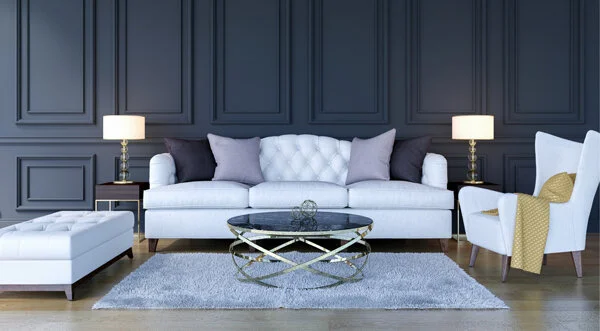Give some added punch to your interior spaces with the use of area rugs.
By Diane Franklin
You’ve painted the walls, freshened up your window treatments and upgraded your flooring with new carpet or hardwood. But something is missing. You can’t quite put your finger on it, so why not put your foot on it instead?
Your missing decorative element could be an area rug. An area rug can provide your room with extra colour, pattern, style and pizzazz. Area rugs come in a wide range of looks—from traditional to transitional to contemporary, and from solids to florals to geometrics. If you’re looking to create a certain mood or evoke a certain culture, area rugs can do this as well as any other decorative element you can name.
You can add an area rug to a variety of flooring types. They look great on hardwood, but also on ceramic tiles, vinyl, decorative concrete—even on carpet.
Here are just a few ideas for using area rugs to their best advantage.
Define a Space
Area rugs are an excellent way to define a space within a room. Let’s say you want to create an intimate seating area in your living room. An area rug can bring the various elements—the sofa, the loveseat, the chair and the coffee table—together as a more cohesive whole.
You also can use a rug to define a dining area, to create a cozy space in front of a fireplace or to designate a pathway from your foyer to your great room.
Define a Style
Area rugs are associated with specific decorating styles—even with different cultures. The most obvious example is the classic Persian rug, originally produced in what is modern-day Iran. These high-quality rugs are known for their intricate woven looks. While authentic Persian rugs can be quite expensive and often are considered an investment, there are reasonable facsimiles that can replicate the elaborate design of the real thing.
Another cultural mainstay is the Oriental rug, which encompasses rugs that evoke the culture of several Asian nations, including China, Pakistan, Afghanistan and Turkey. Persian rugs are actually a subset of the broader category of Oriental rugs. Whereas Persian rugs typically use medallions, tribal patterns and other geometric shapes, Oriental rugs often incorporate natural elements such as florals, landscapes and animals (though intricate geometrics are likewise a theme).
Area rugs evoke many other cultures as well—from the Boho chic look of Morocco to the Native American influences of the American Southwest to the tribal and natural components that are representative of African art.
Homeowners can use area rugs to complement their chosen decorating style. For instance, if the room is traditional, the homeowner may opt for a classic floral pattern in muted colours. If going for a more contemporary style, choosing a geometric pattern in vibrant colour styles will help solidify that look.
Choose the Right Size
Area rugs come in a variety of standard sizes, including 5-by-8, 8-by-10, 9-by-12 and 10-by-13. There are also narrow widths (between 2 and 3 feet long) for hallways and foyers as well as specialty shapes such as ovals and circles.
Ideally, an area rug will be the perfect size for the room or the space you are wishing to define. If you choose an area rug that is too small, you will minimize its impact. Go too big, and it can easily overwhelm the room.
Most rugs come in standard sizes that will typically fit what you are trying to achieve. If you want your area rug to encompass the whole room, you should choose a rug that is 2 to 3 feet shorter than the overall dimensions. For instance, for an 11-by-14-foot room, an area rug of 9-by-12 would be appropriate.
If you want to position your furniture on the area rug, make it extend at least one foot beyond your sofa, love seat and chairs. However, you can also position the rug in the center of the seating area, perhaps with a coffee table on top. The rug will provide a focal point and serve as an anchor for your conversational seating area.
In you want to define a dining area, extend the rug at least 2 feet around all the dimensions of the table. This will allow your dining chairs to rest on the rug, and you won’t have to worry about scraping the hard-surface floor when pushing the chairs out away from the table.
Choose Colour and Texture
When selecting colours for your area rug, take a cue from the other colours in the room. For instance, if you have gray walls, try to include that same gray in the rug. This can be a background or secondary colour that coordinates with other more vibrant, punchier colours in the rug. Also, repeat the accent colours in the rug in other elements of the room, such as the throw pillows, wall art or tabletop accessories.
Textures also abound as options in area rugs. You might want to choose a shaggy rug in a striking solid colour like royal blue or cranberry red. Or you might want to opt for a flatweave rug in a multicolour geometric. If you are strong on environmental choices, you can also select a jute or a sisal rug in a neutral tone.
Area rugs can be swapped out easily with another rug when you change the colour scheme of the room. That’s the beauty of area rugs—they’re portable. An area rug that worked in your living room can eventually work in your dining room, family room or bedroom. Explore the variety and versatility of area rugs, and soon you will want them all over your house.

